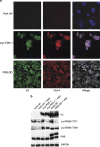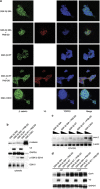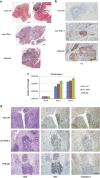Activation of PDK-1 maintains mouse embryonic stem cell self-renewal in a PKB-dependent manner
- PMID: 23455320
- PMCID: PMC3898101
- DOI: 10.1038/onc.2013.44
Activation of PDK-1 maintains mouse embryonic stem cell self-renewal in a PKB-dependent manner
Abstract
The phosphatidylinositol 3' kinase (PI3K) pathway is involved in many cellular processes including cell proliferation, survival and glucose transport, and is implicated in various disease states, such as cancer and diabetes. Although there have been numerous studies dissecting the role of PI3K signaling in different cell types and disease models, the mechanism by which PI3K signaling regulates embryonic stem (ES) cell fate remains unclear. It is believed that in addition to proliferation and tumorigenesis, PI3K activity may also be important for ES cell self-renewal. Paling et al. reported that the inhibition of PI3K led to a reduction in the ability of leukemia inhibitory factor to maintain self-renewal, causing cells to differentiate. Studies in our lab have revealed that ES cells completely lacking glycogen synthase kinase-3 (GSK-3) remain undifferentiated compared with wild-type ES cells. GSK-3 is negatively regulated by PI3K, suggesting that PI3K may have a vital role in maintaining pluripotency in ES cells through GSK-3. By using a modified Flp recombinase system, we expressed activated alleles of 3-phosphoinositide-dependent protein kinase-1 and protein kinase B to create stable, isogenic ES cell lines to further study the role of the PI3K signaling pathway in stem cell fate determination. In vitro characterization of the transgenic cell lines revealed a strong tendency toward the maintenance of pluripotency, and this phenotype was found to be independent of canonical Wnt signal transduction. In summary, PI3K signaling is sufficient to maintain the self-renewal and survival of stem cells. As this pathway is frequently mutationally activated in cancers, its effect on suppressing differentiation may contribute to its oncogenicity.
Figures








References
-
- Hawkins PT, Anderson KE, Davidson K, Stephens LR. Signalling through class I PI3Ks in mammalian cells. Biochem Soc Trans. 2006;34 (Pt 5:647–662. - PubMed
-
- Engelman JA, Luo J, Cantley LC. The evolution of phosphatidylinositol 3-kinase as regulators of growth and metabolism. Nat Rev Gen. 2006;7:606–619. - PubMed
-
- Bader AG, Kang S, Zhao L, Vogt PK. Oncogenic PI3K deregulates transcription and translation. Nat Rev Cancer. 2005;5:921–929. - PubMed
-
- Scheid MP, Woodgett JR. PKB/AKT: functional insights from genetic models. Nat Rev Mol Cell Biol. 2001;2:760–768. - PubMed
Publication types
MeSH terms
Substances
Grants and funding
LinkOut - more resources
Full Text Sources
Other Literature Sources
Research Materials
Miscellaneous

